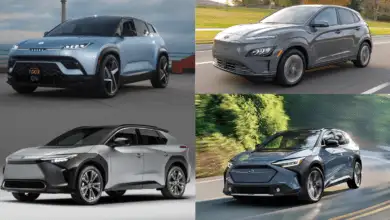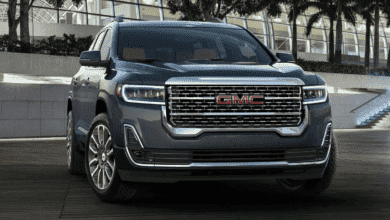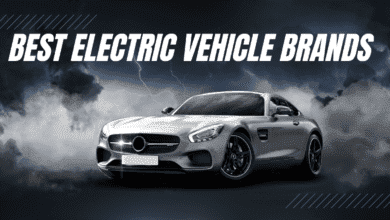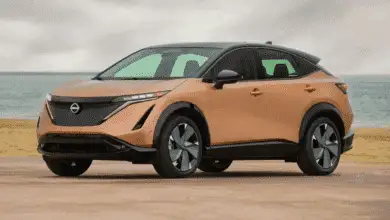Mercedes-Benz EQS 2023 review
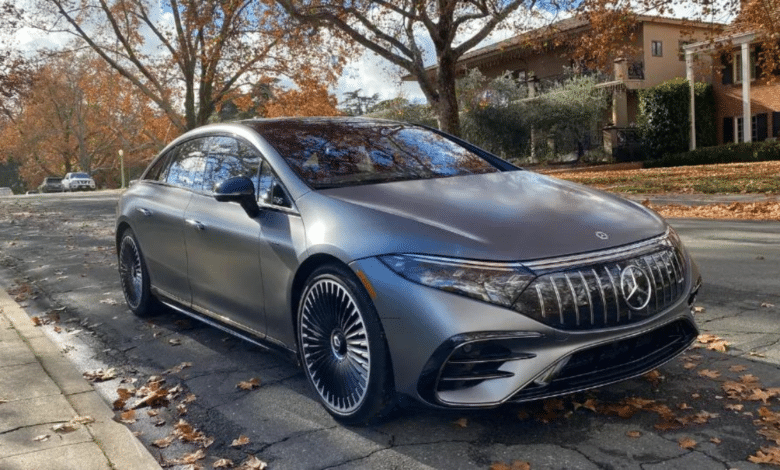
The 2023 Mercedes-Benz EQS sedan is a full-size four-door electric car that resembles a sedan but is a hatchback. There is also an EQS SUV, which is confusing. Its wheelbase is 126.38 inches. The distance between the front and back wheels is approximately 10 inches more than that of its closest rivals. The additional room is mainly used for the luxuriously spacious back seats, which provide extra legroom. In addition to providing a pleasant ride, the ample wheelbase is beneficial for this VIP-only vehicle.
The EQS 450 4MATIC, an all-wheel drive variation of the standard 450+ model, is one of the changes for 2023. The 580 4MATIC and AMG EQS performance versions, both of which are offered with the Pinnacle and Executive trims, are joined by this model. More minor modifications include new 20-inch AMG five-spoke wheels that are available on all models, revised seat cushions and comfort pillows for rear seat passengers in the Pinnacle level, and a new Twilight Blue Metallic color that is only available on the AMG EQS variant.
The Tesla Model S, the Lucid Air, and the Porsche Taycan are the Mercedes-Benz EQS’s main rivals. All of them provide opulent, pricey, high-performance premium vehicles. The EQS has three powertrain choices: a 245 kW rear motor with 329 horsepower and 417 pound-feet of torque (EQS 450+), an all-wheel drive 450 4MATIC, a 385kw dual motor AWD with 516 horsepower and 617 lb-ft of torque (EQS 580 4MATIC) and a 484 kW dual motor AWD with 751 horsepower and 752 lb-ft of torque (AMG EQS).
The Mercedes-Benz EQS has over 5,600 pounds to move when it is in basic form, which makes the zero-to-60 timings for the 450+ ($105,540) and 450 4MATIC ($108,450) a little slower than average for E.V.s. Due to Tesla and Lucid’s superior range and EPA MPGe estimates, the Mercedes’ lesser performance isn’t helpful. The $58,000 580 4MATIC accelerates things. After spending a week behind the wheel of the Mercedes-AMG EQS ($148,545), the most powerful model, we discovered that the quietness and silky ride of an E.V. nearly reminded us of old, ultra-isolated luxury cars—until we stepped on the accelerator.
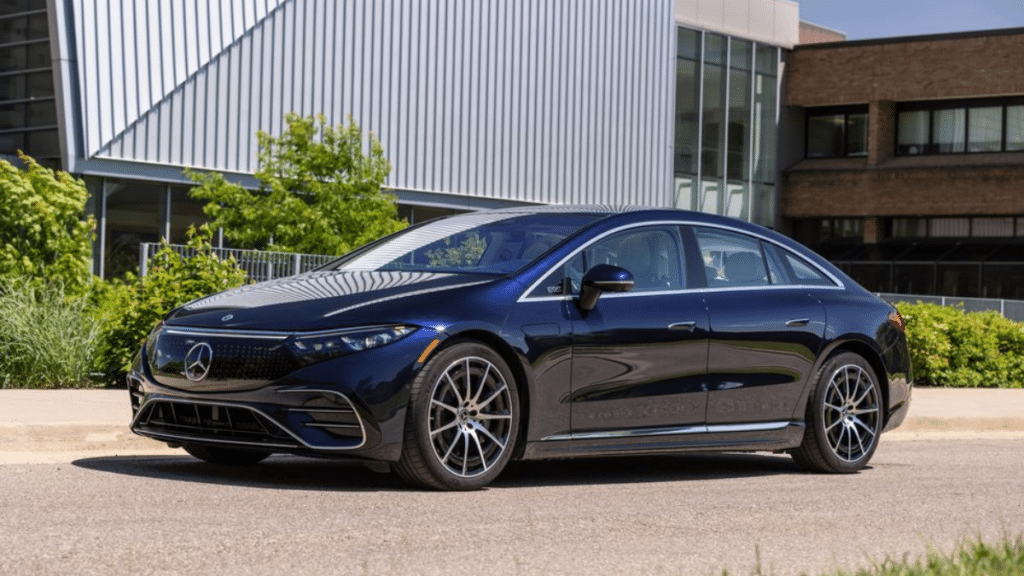
The EQS’s interior combines classic Mercedes design elements (luxurious but professional) with cutting-edge technology, including a large central screen and 64-color ambient lighting. In our opinion, the only safe method to make certain modifications is to pull over or learn the “Hey, Mercedes” voice commands and hope the car understands what you’re trying to say. The best in the group in terms of space and comfort for the driver and passengers and excellent luggage capacity is achieved by choosing a hatch over a trunk.
Although the EQS’s emphasis on technology has certain disadvantages, Mercedes provides every active safety feature currently available as standard. Even with D.C. fast charging stations, the EQS does not charge very quickly, yet its 31-minute time from 10% to 80% is decent. EQS is an expensive E.V. designed for luxury consumers who want a high-quality interior to relax while enjoying peaceful, emission-free driving, regardless of your chosen model.
Performance: Mercedes-Benz EQS
The EQS 450 has the slowest zero-to-60 speed (5.9 seconds compared to the Model S’ 3.1, the Air Pure’s 3.8, and the Taycan’s 5.1 seconds), but it has the next-to-fewest horsepower (329, as opposed to the Tesla Model S’ 670, the Air Pure’s 480, and the Taycan’s 240). The closest models from Tesla, Lucid, and Porsche all outperform it. Moving up to the EQS 580 increases the horsepower to 516 and reduces the zero-to-60 time to 4.1 seconds.
The Porsche Taycan Turbo S, which only has 460 horsepower but weighs 810 pounds less than the AMG EQS, has 460 horsepower; the Tesla Model S Plaid, which has 1,020 horsepower; the Lucid Air Grand Touring, which has 1,050 horsepower, and the Mercedes-AMG EQS, which has 751 horsepower. The AMG equals the Lucid’s zero-to-60 speed of 3.0 seconds, although it lags behind the Taycan Turbo S’s (2.6 seconds) and the Model S Plaid’s (2.1 seconds) times.
The only rear-wheel-drive EQS model is the 450+. Mercedes’s 4MATIC or 4MATIC+ all-wheel drive is standard on all other models. Depending on the model, Tesla, Lucid, and Porsche are available in RWD or AWD.
The EQS functions quietly and effortlessly, as you would expect it to for a machine that prioritizes comfort. The driving modes of the EQS significantly alter the dynamic feel, with Sport living up to its name by moving forward far more quickly than Comfort and Eco—but at the sacrifice of range. It doesn’t matter what setting the vehicle is in; bends and more challenging driving situations make it seem huge and heavy. Turn to the AMG for a genuine sporting experience in a limo-like setting.
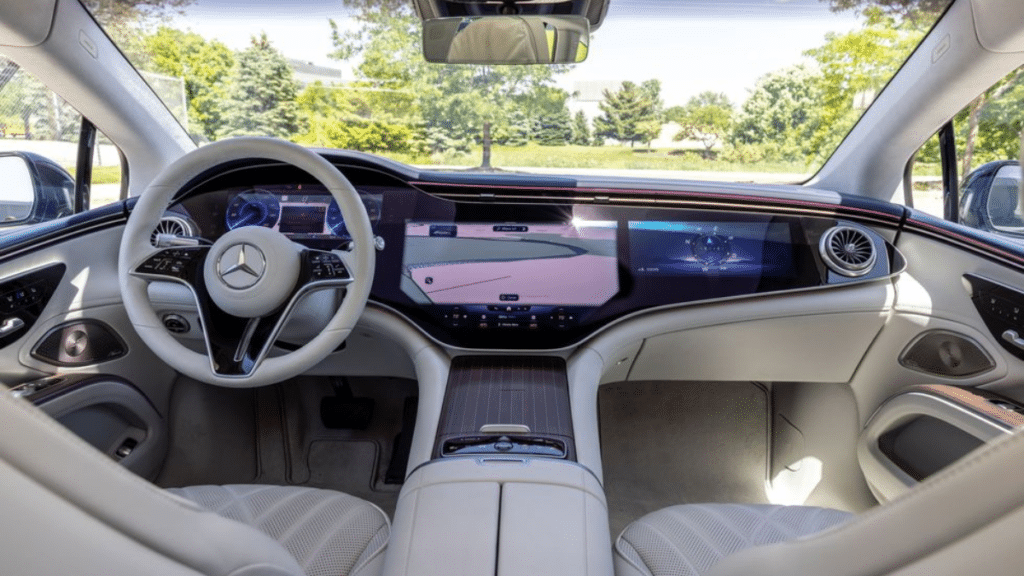
Range, power use, and charging
The EPA uses a statistic called MPGe to calculate the fuel efficiency of electric cars. Based on calculations made by the EPA, a gallon of gasoline has the same amount of energy as 33.7kWh (kilowatt hours) of electricity.
The EQS ranks second-to-last in the competitive group with an EPA estimate of 93 MPGe, averaged across all models in the series. The Tesla Model S and Lucid Air perform much better (110.5 and 127.3 MPGe, respectively) than the Porsche Taycan, which performs worse at 80.8 MPGe.
With 350 miles for the EQS 450+ and 450 4MATIC, 340 miles for the 580, and 277 miles for the AMG, the EQS once again comes in third in terms of range per charge. Only the Taycan has a lower range per charge (206 to 246 miles, depending on model), but Tesla claims the Model S and Model S Plaid have capacities of 410 and 396 miles, respectively. Range-wise, Lucid’s Air comes out on top, estimating 410 miles for the Pure model, 425 miles for the Touring, and 516 miles for the Grand Touring. The usual range of E.V.s in this category is pushed to new heights, making the 350-mile range seem insignificant.
With an estimated 10% to 80% charge in 15 minutes on the company’s exclusive Supercharger network, Tesla has the edge in public charging. Porsche, which has 800-volt charging capabilities, predicts a 350 kW D.C. fast charger would complete the same recharge in 22 minutes. Both Mercedes and Lucid claim to be able to complete the task in 31 minutes.
Most E.V. owners charge at home using Level 2 (240 volts) chargers while they aren’t on the road. Porsche, Mercedes, and Lucid assert that the charging time is between 10 and 11 hours, while Tesla claims that the charging time from 10% may take up to 12 hours.
Safety and driver support technology:
The Mercedes-Benz EQS comes equipped with every imaginable active safety feature, and the company is known for its commitment to security. Nevertheless, the National Highway Transportation Safety Administration and the Insurance Institute for Highway Safety (IIHS) have not yet assessed the EQS’s crashworthiness.
The Lucid Air, which has an overall ” Good ” grade from the IIHS, is the only car in this competitive group to have undergone crash testing by either U.S. organization. The European New Car Assessment Programme (Euro NCAP) has evaluated all four vehicles—the EQS, Model S, Air, and Taycan—and has given them all five-star ratings.
Comfort and Space
Rear-seat passengers in the EQS benefit from its size advantage as they enjoy 37.8 inches of legroom. That surpasses the Lucid Air’s 37.4 and the 35.5 of the Tesla Model S. For the four-seater Taycan, Porsche does not explicitly mention back seat legroom, although it is limited. The aerodynamic design of the EQS has one drawback: the rear headroom is somewhat less in the EQS, measuring 38 inches, as opposed to 39.4 inches in the S-Class.
The front passenger and driver’s seats include essential heating and ventilation, and multi-program massage features are available in additional cost option packages. The seats are very supportive and comfy. Nappa Leather is a premium upgrade with high-quality textile alternatives. The inside of the EQS is a castle in comparison to the Tesla. The Pinnacle level comes standard with heated and ventilated front seats but does not offer either for the back chairs. The Exclusive trim’s heated steering wheel costs an extra $250.
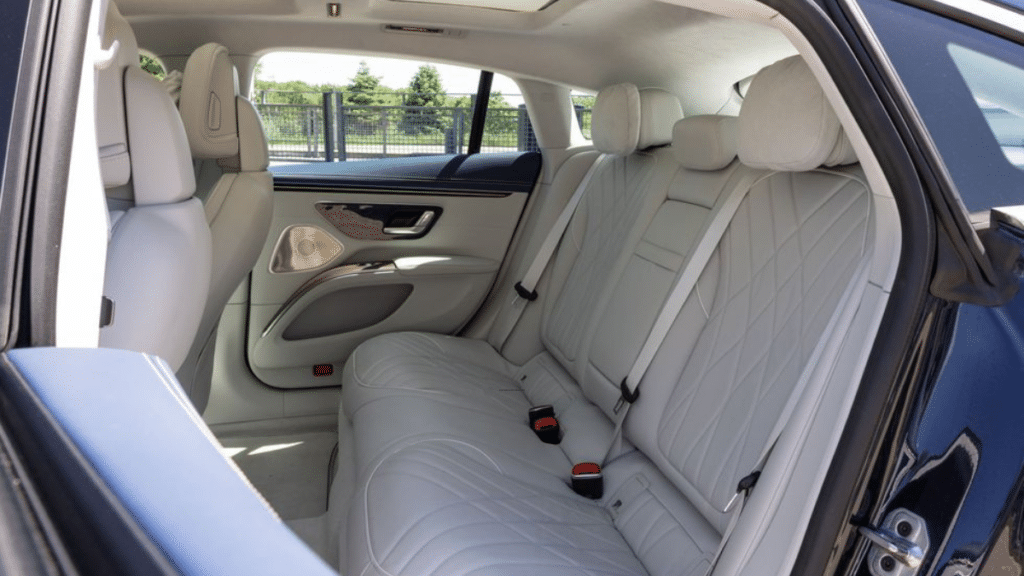
Infotainment: Mercedes-Benz EQS
The inside of the EQS is a hybrid between a posh European automobile (which it is) and the CES tech conference floor, replete with 64-color ambient lighting. Even with the primary instrument panel, that is.
A Burmester 3D Surround Sound system and augmented navigation, which provides a 3D photorealistic view of your surroundings, are standard equipment. On the Exclusive and Pinnacle Trim editions of the EQS 450, other animated displays depict energy flow (from the battery to motor, from brakes to battery), massaging front seats, a cabin aroma system, and other features.
The Hyperscreen is a standard EQS 450 and 580 feature and an optional package on the Mercedes-AMG EQS. Three giant screens are hidden underneath what seems to be a single continuous screen across the instrument panel. The instrumentation on the one in front of the driver (12.3 inches) is standard and includes a speedometer, range estimate, trip odometer, and much more. A 12.3-inch display that may display a clock, altitude, compass, navigational options, or music is also provided for the front passenger. 17.7 inches of infotainment (navigation, radio, temperature control, and energy monitoring) are located in the middle.
It’s a beautiful show, but ultimately, too many fundamental operations that ought to be easily accessible without diverting attention from the road are managed by a system that necessitates precisely tapping the proper location.
Storage & Cargo Space:
With the rear seats in position, the Mercedes has an average luggage space of 22 cubic feet, despite the choice to create the EQS as a hatchback rather than a sedan with a trunk. The Lucid Air has a total volume of 32.1 cubic feet and includes a box and ten cubes of the front compartment (“frunk”). The hatchback Tesla Model S achieves 28.1. It only has less than the tiny Porsche Taycan, which has 17.2 cubic feet. The Tesla edges out the Mercedes, 64.5 cubic feet to 63 when the back seats are folded flat.
With the typical glovebox, center console compartment, and door pockets, the little storage capacity is acceptable but unimpressive. The EQS’s lack of a frunk makes a hold under the rear cargo area the ideal location to store cords and charging accessories.
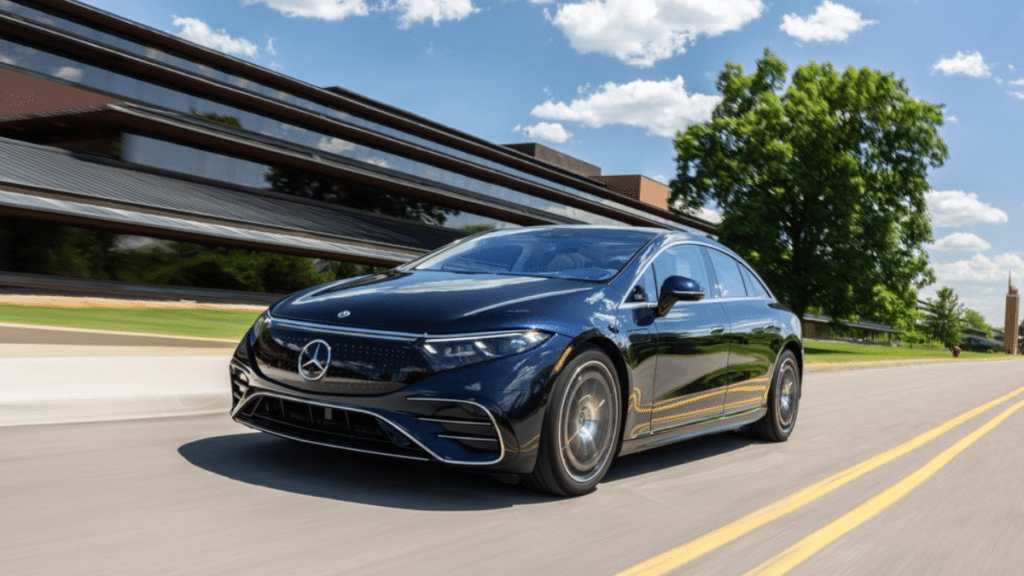
Design: Mercedes-Benz EQS
Although the EQS’s appearance may have aerodynamic benefits, it lacks the distinctiveness of the gasoline-powered S-Class sedans and comes out as uninspiring and lozenge-like. It may seem more modern than the almost ten-year-old Tesla Model S in the AMG version, but it is nothing special compared to the gorgeous Lucid Air and the sporty Porsche Taycan.
The Mercedes touch is evident in the materials and craftsmanship. While Teslas sometimes have inconsistent builds, the EQS seems to have undergone several quality-control inspections. The luxurious VIP limo seats inside are all about comfort. The AMG variant has a sportier look, although still high-quality.
The Mercedes EQS 2023: Is It Worth It?
The Mercedes-Benz EQS 450+ has a base price of $105,540 (destination included). Four-zone temperature control, a cabin aroma and purification system, and massaging front seats are all included with the exclusive trim (a $3,400 option). The back compartment is the main emphasis of the Pinnacle trim (a $6,200 upgrade), which also includes heated and ventilated seats, luxury head restraints, power adjustment with memory, wireless charging, and rear side-impact airbags. All-wheel drive may be added by upgrading to the EQS 450 4MATIC ($108,450).
The Exclusive and Pinnacle small items are available for the extra costs on the Mercedes-Benz EQS 580 4MATIC, starting at $127,000.
With a starting price of $148,550, the Mercedes-AMG EQS also allows upgrades to the Exclusive and Pinnacle trims for the exact extra costs. The main difference is that the AMG EQS has an enormous Hyperscreen, massaging front seats, and a fragrance/purification system.
Any way you slice it, the EQS is a pricey electric vehicle. Other high-end E.V. choices are priced similarly to it, but several provide superior performance (Model S Plaid) or range (Lucid Air). In particular, compared to the EQS cost, the new basic Pure trim on the Lucid Air will soon be the most excellent offer for a high-performance luxury E.V.
Nevertheless, depending on local weather and driving circumstances, we recommend a six-figure ultra-luxury electric car from Mercedes: the 450+ or EQS 450 4MATIC. It isn’t easy to rationalize giving up 10 miles of range for each charge and paying an additional $18,550 to $21,550 to obtain the same performance, even if the EQS 580 accelerates to 60 mph, nearly 2 seconds faster than the 450.
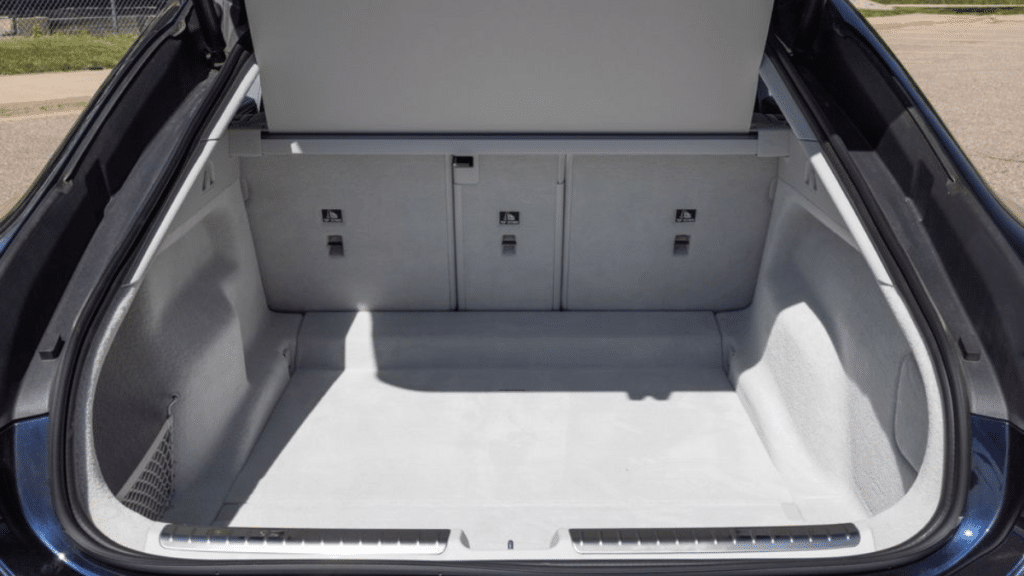
How Much Does the 2023 Mercedes-Benz EQS Cost to Insure?
Like most of its competitors, the EQS is costly to insure. Though this averages all 50 states, a typical 30-year-old female driver with a clean record should anticipate an average yearly premium beginning at $5,380. Owners of Lucid Air might spend under $5,000 annually, compared to $4,430 for the Tesla Model S, $5,468 for Plaid, and $5,160 for the Porsche Taycan.
Verdict
The Mercedes-Benz EQS sedan from 2023 competes in an electric car market niche that doesn’t emphasize utility or cost-effectiveness. Except for the Lucid Air, these expensive cars don’t advertise the cost savings from not needing to fill up with petrol and having less maintenance. The conventional qualities of a luxury sedan, including comfort, spaciousness, entertainment systems, and safety, are where the EQS excels. When considering the distinctive attributes of E.V.s, the EQS falls short since it is slower and has a shorter range than every other vehicle in the set save the Porsche Taycan.

